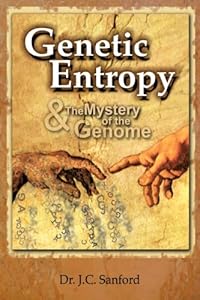Laszlo Bencze offers these thoughts on genetic mutations seen from the perspective of art:
I’ve been very much enjoying my read of John Sanford’s Genetic Entropy. His main thesis is that not only are beneficial mutations so rare that no one has ever seen one, but that if one happened to pop into existence it could not be selected by natural selection. The reason for this unselectability is that any reasonably small mutation of the sort that Darwinians assume to be the driving force of evolution produces a fitness benefit too small to be “visible” to natural selection.
By the same token small deleterious mutations are likewise invisible to natural selection and cannot be selected against. However, harmful mutations truly are frequent and do accumulate in the genome of species. Thus, the genetic structure of any species inevitably deteriorates, hence “genetic entropy.”
Now the big question is whether there are mutations that are genuinely neutral and have no effect one way or the other. Sanford argues that there are not and, furthermore, that there cannot be any such. In order to understand his point better I came up with this art analogy:
Here is a famous and gorgeous painting by Ingres which I just saw in person at the Frick Museum in New York [click the link if you cannot see the painting below. – ed.].
Let’s imagine we can improve it by adding a dot of paint 1mm in diameter to it. In evolutionary terms we will give it a “point mutation,” the smallest possible change. If we add this dot randomly, the odds are pretty high it will damage the painting by creating an obvious, intrusive speck. So let’s give evolution every advantage. Let’s make the process far more likely to succeed by having the great contemporary painter, David Hockney, add the speck wherever he thinks it will “do the most good.”
Now I happen to know that Hockney is a great admirer of Ingres and would be shocked and dismayed at any such request. But if a cruel tyrant under pain of death forced him to do it, Hockney would understand that there is no place he could possibly place a dot of paint that would improve the painting. Like a living thing, the painting is so well crafted that anything he might add to it could only be neutral at best. So Hockney would strive to place the most neutral dot he could by choosing a pigment that matched some dark portion of the painting and hope to hide his speck there.
But would such a speck be truly neutral? No matter how well it matched the color, wouldn’t it be visible as a raised dot under the right lighting conditions? And wouldn’t that actually damage the painting even if ever so slightly? And this is precisely Sanford’s point. In the world of biology it is impossible to create a neutral mutation. The change may be extremely slight, even invisible, yet always a degradation no matter how small.
Now imagine the tyrant demands Hockney place a thousand dots on the painting and any notion of neutrality evaporates. There’s no way so many dots would not be apparent even without special lighting. The painting would be damaged. Mutations cannot create any improvement. Even the least of them will introduce some speck of damage. Let the process continue for enough generations and the host of near neutral mutations will show up as visible flaws.

